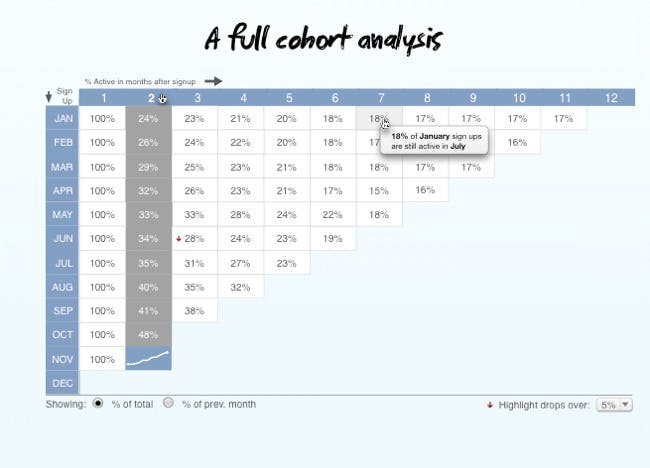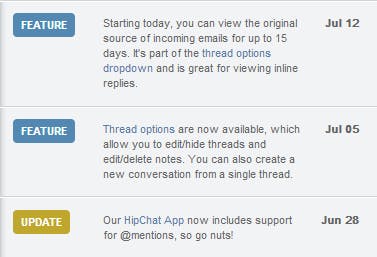How to Take Charge of Your Churn Rate


A company’s churn rate, which is defined as the proportion of customers who leave during a given time period, is a highly important metric that should be tracked by all subscription-based businesses.
Churn rate can mean different things to different companies (read here for more information), but in the most basic sense your churn rate lets you get a sense of how your business is doing with retaining customers.
Today’s post takes an in-depth look at what companies with a high churn rate can do to convince customers to stick around. We’ll also identify some unexpected sources of high churn rates. (Hint: Take a hard look at how you acquire customers.)
Try the customer support platform your team and customers will love
Teams using Help Scout are set up in minutes, twice as productive, and save up to 80% in annual support costs. Start a free trial to see what it can do for you.
Try for free
Best Practices for Reducing Your Churn Rate
One of the most insightful writers on churn is Intercom's Des Traynor. All of his older posts on Inside Intercom (the company blog) discussing churn are gems. I feel some of the older pieces haven't received the audience that they deserve, so today I wanted to highlight some of his (and others) best visualizations and insights on churn. Be sure to subscribe and check out the many articles from Des that I'll cite below.
1. Talk to Customers
The most direct way to figure out why customers are leaving is to simply reach out to them and get feedback on what you are doing wrong and how you can make it right.
Many product departments get overly focused on trying to determine what users want, which then spirals into internal debates around vague topics like “simplification” and the onboarding process.
These discussions in themselves are fine, but they can often make teams oblivious to the fact that their best source of information—the customers!—are just a phone call, email or quick survey away.
Intercom COO Des Traynor has described this inability to go directly to the source first as a parallel to couples with relationship problems:
"It’s oddly similar to how people are happy to discuss relationship problems with a radio DJ and her two million listeners, rather than, dare I say it, talk to their partner.”
As an added bonus, you’ll find this outreach welcomed by many customers who view the personal touch as a lost art. Let competitors stick to faceless forms or one-size-fits-all questionnaires while you get in touch with customers to directly solicit candid feedback on what you could be doing better.
2. Improve Your Service and Educational Materials
Hopefully you saw this one coming from a mile away.
There is no doubt that great service is an important element of customer loyalty and retention. A large sampling of consumer data (e.g., RightNow experience surveys) has shown poor customer service as a leading cause of customer attrition. Specifically, the top two customer complaints were incompetent and rude staff followed by unbearably slow service.
But what many companies forget is that engagement with customers can often be improved by offering them more education. Management studies have shown that relationship marketing can increase retention and thus reduce churn. The HubSpot academy offers great examples of this practice in action:

HubSpot sells the software and tools for marketing campaigns, but they grow their relationships with customers by also offering free trainings on how to successfully use the software. For customers who have heavily invested (and seen results) from HubSpot’s advice, what’s the point in “dating around” with the competition?
HubSpot customers’ needs are met and exceeded through the powerful combination of a tool that works and training that helps them use it well. Consider how your company might supply educational content to help customers get the most value out of your products.
3. Identify “At-Risk” Customers
Automation in marketing is a hotly debated topic, but it’s a useful tool for targeting your customers at risk of churning.
This concise post on Customer.io’s blog lays out the basic premise for identifying an at-risk customer: If a customer hasn’t logged on for quite awhile, it’s likely that the next bill will cause them to churn.
To reach out to these customers in hopes of bringing them back into the fold, you’ll need to create a triggered email that is sent out when their activity takes a dip. But a word of warning: To avoid annoying active users who just happen to be away, be careful about the timing of this email.

As Des Traynor highlights in this article and in the graphic above, a catch all "Please come back!" email is a disservice to your customers because it treats them all the same. Des identifies some other must-use methods in your retention emails that can help in getting customers to return without making them frustrated:
Segment and change customer messaging. You will have often have very different customers who are about to churn. Some may be trial accounts on their way out, and other may be long time customers who have lost faith or interest in the product. You should be sure to differentiate communications between these groups to avoid catch all messaging that gets the wrong incentive across.
Create a personal experience. Remember that personalization can go a long way. Craft the copy of your retention emails so that customers get the sense that you or your team are standing by to hear them out.
Give incentives. In order to truly encourage people to come back, it works best if you are direct and offer them a real incentive. What improvements are under way? Are any new features being added? Are problems/bugs getting fixed? At the end of the day, the what’s in it for me criteria are the threshold these emails must meet.
4. Reevaluate Your Marketing
Sometimes a high churn rate results from attracting the wrong type of customer. Is this the case for your company? To find out, you must first reevaluate your customer personas and assess whether or not you are currently targeting (and appealing to) customers who benefit the most from your product.
You also need to be careful about monitoring your “vanity metrics.” Seeing thousands of new visitors pour in feels great, but what if they aren’t actually converting?

As Des showcases in this post (and mock analytics graphic), it is often the case that a churn problem isn’t really a churn problem—it’s a segmentation and acquisition problem.
Do your acquisition strategies need adjusting? If you identify with any of the scenarios below, then the answer is yes.
You’re saddled with “barnacle” customers. There are a few types of customers that you need to look out for; “barnacle” customers are a whole heck of a lot different than your superstar advocates. This disparity is often as simple as the difference between your free users (if you offer a free version of your product) and your paid users.
Des explains here that the language they use to make requests will often tell you which type of customer you are attracting:

Also keep a lookout for new users who immediately ask for a discount; that’s a red flag that they aren’t your ideal customers. Find out where these users are coming from and reevaluate the usage of that channel.
No one is talking about your competitive advantage. If you’re not hearing customers rant and rave about your competitive advantage, then you’re probably attracting the wrong people.
Entrepreneur David Skok discusses this point in relation to the early HubSpot product, which suffered from high churn because it was too focused on SEO (people would use the software to search-optimize their site, then leave).
Your competitive advantage should be what makes customers stick. Many Help Scout customers praise the product’s simple nature as compared to more complicated and bloated help desk alternatives.
Your pages are too vague. Trying to assemble a catch-all homepage isn’t sufficient if you’ve identified more than one type of ideal customer. Why segment your customers if you aren’t willing to segment your copywriting?
5. Conduct a Cohort Analysis
A cohort analysis, which examines segmented user behavior over a particular time span, can be useful for your marketing efforts.
Consider this example from Google’s Analytics Advocate Justin Cutroni:
"If I was an ecommerce business owner I would want to create a cohort of customers who make their first purchase on Black Friday. This cohort is important because they made their first purchase during a very important time, the holiday buying season.”
Keep things simple when identifying your cohort. You will want to gather data for, and later visualize, a starting condition (e.g., when the customer signed up) and the variable (e.g., the customer’s activity over time).
An example cohort, as explained here at Intercom, might look something like this:

As Des explains, these parameters show a snapshot of the amount of customers that sign up at Date X and are still active after Date Y. The cohort analysis offers a variety of data insights, including when customer are actually being lost, and if the the rate at which you are losing customers is improving (or getting worse).
Des goes on to cite a really great piece on cycle plots, which can be used to take a simple chart such as this:

...and include multiple months on the same chart. As you'll see in this piece by Des, these cycle plots can be used to compare the retention rates for months two, three, four and five on the same graph:

How do you use the results of the cohort analysis? As outlined in this post by Kareem Mayan, if you discover that, for example, the average customer cancelled their subscription after 61 days, you can adjust your onboarding tactics and follow-ups to better match customer behavior.
6. Improve Onboarding with Clear Communication Practices
The way you communicate with prospective and new customers is critical to the formation of a relationship that meets their product expectations.
"The best reason to automatically ask people for cancellation reasons is that within an hour you'll get email, say "IT DOES DO THAT!", & fix."
(In other words, an automatic email that asks people why they left will often reveal that they thought you didn’t have a certain feature, when the reality was that you did!)
As software developer Patrick McKenzie points out in this post, there’s a big opportunity here to improve the step where most online businesses lose a lot of potential customers—the first-run experience:
"40-60% of users who sign up for a free trial of your software or SaaS application will use it once and never come back.”

(Patrick explains here that many users won't stay after logging in once. There's an opportunity to improve the process to get people to come back for a second experience.)
Here are a few steps businesses can take to improve the onboarding process and reduce a customer’s likelihood of churning:
Invite new customer feedback.
A simple, personal note explaining that you are always available for customer assistance can go a long way toward helping customers get started. It can also result in useful feedback from new users, which is important for understanding what their first impression of your product is and if there is anything that is making them consider abandonment.
Don’t bombard customers.
The best online courses are carefully staggered so that you don’t get overwhelmed. Why, then, do so many software companies insist on a full assault to teach new customers everything at once? Even the best apps have features that aren’t immediately apparent or useful (anyone who was initially confused by—but eventually embraced—Evernote can speak to this!).
Start with quick “wins” during the initial product tour, introducing customers to user elements that they might already be familiar with, such as notifications. It’s hard for new users to care about your data exporting abilities when they don’t have any data yet to export. “Dripping” out these features gives users more reasons to love your product as time goes on. For advanced users that want to see the full suite of tools right away, keep a showcase of feature tutorials in your FAQs section.
Make announcements in-app.
Customers do notice if your development progress has gone dark for some time. They begin to wonder, “Is this team still around? Are the features they mentioned ever going to be built?” If you are too quiet for too long, competitors will start looking better and better.
At Help Scout, we include a simple sidebar with progress updates that everyone sees when logged in:

The delivery method isn’t the most vital aspect (maybe a notification bar works better for your UI). The important thing is to make sure these progress updates are in your product’s dashboard, since customers tend to only care about them when they are actually using your product.
The Supportive Weekly: A newsletter for people who want to deliver exceptional customer service.